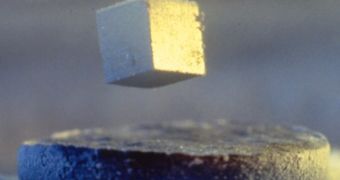Certain metals can be determined to act as superconductors, when cooled to temperatures close to absolute zero, or 0 K. The effect was discovered at the beginning of the 20th century, when a Dutch physicist by the name of Kamerlingh Onnes designed an experiment to observe how certain materials behave at low temperatures and he discovered that their electric resistance suddenly drops to zero when a certain temperature is reached, meaning that basically electrons are flowing through the metal without encountering much resistance.
The first theory about what really produced this effect was published in 1957, when three physicists showed that electrons synchronize their motion in the material by pairing up, to produce an effect known as Cooper pairs. The group of physicists which unveiled the BCS theory of superconductivity, made up of John Bardeen, Leon Cooper and Robert Schrieffer, eventually won the Nobel Prize for Physics as a recognition of their work.
In a research made by physicists from Brown University, regarding the Cooper pairs, it is shown that the surprising Cooper pair effect can also determine the same materials with superconducting properties, to become extremely effective insulators.
The team decided to use bismuth, a rare metal element of Earth, which when disposed in large structures acts as a superconductor, but when in thin sheet-like structures, serves as an excellent insulator. For the experiment, they have used a honeycombed template that presented holes measuring only 50 nanometers in diameter, coated with a layer of bismuth only four atoms thick, which when cooled at temperatures close to 0 K, behaved either as a superconductor or an insulator. The presence of the Cooper pairs was detected by applying magnetic fields to the material when it behaved as an insulator, by measuring the change in the electric current.
The Cooper pairs cause a material to act as a superconductor when pairs of electrons which bond with other pairs move in linear trajectories to create a stream of electrons that will allow the electric current to flow. However when the material behaves as an insulator, the paired up electrons spin alone locally, preventing the pass of electric currents, the same way a whirlpool spines in the same place.
The research provided by the Brown team may prove essential in the understanding of the limits regarding superconductivity and could offer solutions to creating insulated wire for electric current transport that conduct electricity without losing power through by heating up.

 14 DAY TRIAL //
14 DAY TRIAL //